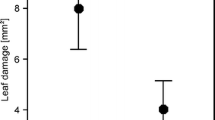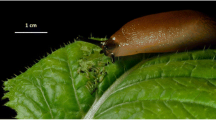Abstract
Suppression of shared prey populations by insect predators can be influenced by interactions among these predators (intra-guild interactions). Intra-guild interactions among predators attacking herbivores may be influenced by plant characteristics, but this possibility has not been examined. Plant surface waxes are a ubiquitous and variable morphological feature that are known to affect insect predator behavior, and potentially in- fluence inter-predator interactions. To test this possibility we measured the effectiveness of individual and multiple predators on Pisum sativum L. lines with either wild-type crystalline waxes (normal waxbloom) or with reduced waxbloom resulting from a genetic mutation. On caged five-node plants of each line, reduction in populations of Acyrthosiphon pisum (Harris) (Homoptera: Aphidae) by individuals or pairs of second-instar Hippodamia con- vergens Guerin de Meneville (Coleoptera: Coccinellidae), and second-instar Chrysoperla plorabunda (Fitch) (Neuroptera: Chrysopidae), was significantly greater on the reduced waxbloom plants. Intra-specific interference by H. convergens depended on plant waxbloom type. Pairs of H. convergens larvae were no more effective than individuals of this species at reducing aphid populations on normal waxbloom plants, indicating interference, but were additive in their reduction of aphids on reduced waxbloom plants, indicating no interference. In contrast, pairs of C. plorabunda apparently interfered regardless of plant waxbloom type; pairs were no more effective at reducing aphids than individuals of this species. Heterospecific pairs of H. convergens and C. plorabunda were more effective on reduced waxbloom plants and showed no evidence of interference on either waxbloom type. Differences in behavior of the two predator species provided a partial explanation for the asymmetrical effect on intraspecific interactions in the two species. H. conver- gens spent significantly more time walking and less time ”scrambling” (ineffective locomotion) on reduced waxbloom plants than on normal waxbloom plants, and distributed these activities differently among plant parts on the two waxbloom types. In contrast, C. plorabunda spent the same amount of time walking and scrambling on each waxbloom type, although they distributed this walking and scrambling differently among plant parts of the two waxbloom types. The stronger influence of plant waxbloom on H. convergens behavior is consistent with the difference in intra-specific interference for this species on the two waxbloom types. The mechanisms of intra-specific interference by H. convergens on normal waxbloom plants and by C. plorabunda on both waxbloom types were not determined.
Similar content being viewed by others
Author information
Authors and Affiliations
Additional information
Received: 14 July 1999 / Accepted: 10 January 2000
Rights and permissions
About this article
Cite this article
White, C., Eigenbrode, S. Leaf surface waxbloom in Pisum sativum influences predation and intra-guild interactions involving two predator species. Oecologia 124, 252–259 (2000). https://doi.org/10.1007/s004420000374
Issue Date:
DOI: https://doi.org/10.1007/s004420000374




